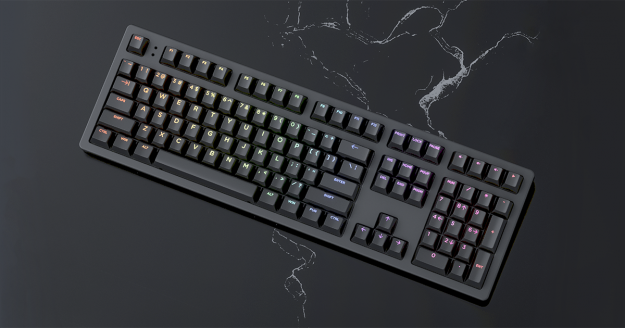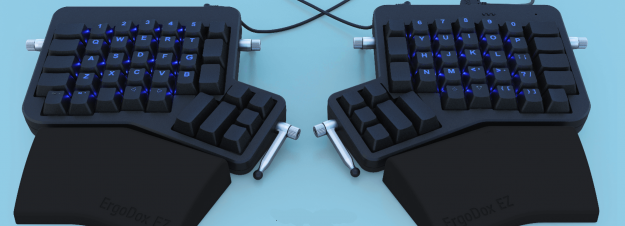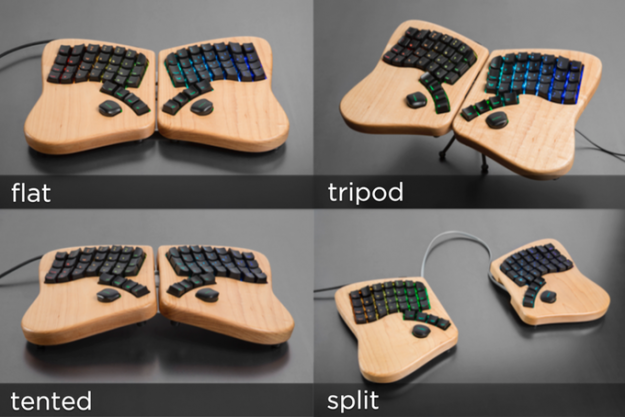As open source hardware becomes a real thing, open keyboard companies are redesigning the input device from the ground up using open designs.

If innovation is stalled on the desktop, it’s thriving in open hardware. Computers with free firmware, cheap prosthetics, the open source RISC-V architecture — name any innovation that has been confined to speculation in the last decade, and chances are someone is trying to realize it with the help of crowdfunding. One of the strongest examples of this trend is the open keyboard community, which is at the fore of the latest developments.
Although many of us spend hours each day at a keyboard, most users rarely think of keyboards. They use a full size keyboard with a standard QWERTY layout. Unless they happen to be gamers, they use a membrane keyboard, in which characters are typed by bring two pressure points in contact with one another, a cheap technology that wears out quickly. Meanwhile, unknown to most of us, an open source keyboard community has been working for close to a decade to bring more advanced technology into wide use.
The world of keyboards is a field with jargon all its own. For instance, preload is the pressure needed to activate a key, and bounce how quickly a key is read to use again. Similarly, tactile (quiet) and clicky (loud) keys refer to how much sound keys make to give users feedback. Even more importantly, top of the line keyboards — usually inspired by the demands of gamers — include programmable keys and layers, which allow the same keyboard to support both QWERTY and Dvorak layouts, or one layout for programming in Vim and another for painting in Krita. Among the initiated, there is also a strong preference for mechanical keys, each with its own mechanism or keyswitch, and all of them longer-lasting than membranes and replaceable if damaged. As well, keycaps — the parts that fingers strike — are also usually removable. Keys are backlit. All these terms and technologies are endlessly debated, but most advanced keyboards have all of them.
Some advanced keyboards are also ergnomically designed, with a level of development far beyond the supposedly ergonomic designs sold by companies like Logitech or Microsoft. Advanced ergonomic keyboards feature vertical rather than diagonally stacked keys, and curved key banks, both of which reduce the distance fingers have to travel and the strain of reaching for keys. Most are divided into two halves that can be arranged at various angles and distances from each other. A few also have keycaps sculpted so that fingers can slide more easily from one to the next.
In the open hardware community, three commerical efforts stand out: ErgoDox EZ, Keyboardio, and Input Club.
ErgoDox EZ
ErgoDox EZ is a pioneer in ergonomic keyboards and a community favorite. Its website emphasizes physical customization and a selection of keycaps. The page for ordering a keyboard will guide you through the general options, and is especially useful for those who want to know which keyswitches are loud or silent, or best for the office or for gaming. Some (including me) find the general design ugly, but for those who judge on functionality rather than aesthetics it remains a popular choice. Because the design is open source and therefore unpatented, it has been copied by others, including Input Club.

Keyboardio
Keyboardio includes all the features that are typical of an advanced keyboard, and adds the aesthetics of maple enclosures. The fact that it is only now, after twenty months, starting to ready a graphic configurator does not seem to have reduced the popularity of its Model 01 product, possibly because its technical support is quick to respond and it’s supported by an active community.
The Model 01 is designed for touch-typing, with fingers drooping from the wrists. That means that it lacks wrists support, although there is room on each half to add your own. However, with 61 of 66 keys custom-sculpted for easier movement of the fingers, the Model 01 is is perhaps the most ergonomic keyboard on the market today. I can personally testify that it reduces repetitive stress injuries — with some sources citing a roughly 90% reduction.

Input Club
Input Club began by selling do-it-your keyboard kits, including the Infinity ErgoDox. These kits are still available, but require soldering. In the last few years the company has started shipping assembled keyboards in a variety of sizes. Its prices are roughly two-thirds of ErgoDox EZ’s or Keyboardio’s.
In January 2020 Input Club plans to release the Keyboard Magnetic Analog. This model promises new magnetic keyswitches that have two states, half and fully depressed, which will allow more use of a single layout without the addition of macros. The Keystone Analog will also have the ability to learn from your typing, so that if one finger is weaker than another, the keys it presses will respond to less pressure. When released, the Keyboard Analog will be the equal of any keyboard on the market, regardless of whether its license is free or proprietary.
Innovation in Unexpected Places
The keyboard is one of the last places to expect innovation. The keyboard that most computer users spend their day over has changed little in the last three decades. However, as these three examples of open keyboards show, small open source companies are upsetting those expectations. Not only are they are selling long-lived and repairable keyboards that are usually found only in gaming keyboards for general use, they are the forefront of innovation, offering features that industry giants like Logitech have yet to match.
Remember the days when open source was struggling to catch up? In the case of keyboards, open source is not only matching the hardware found at your local mall, but are serious contenders in their field.
Bruce Byfield has been involved in FOSS since 1999. He has published more than 2000 articles, and is the writer of “Designing with LibreOffice,” which is available as a free download here.





There’s also the Planck keyboard from olkb.com
ErgoDox-EZ also sells them: ergodox-ez.com/pages/planck
Personally I really like the Planck: Simple but powerful.
One thing I really is the open source firmware, and the fact that none of the keyboards’ custom functions are dependent on having some special application running all the time (think Logitech). Program the keyboard, plug it in another computer and it works just the same.